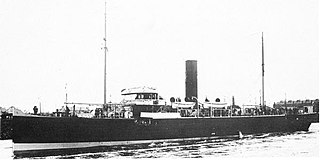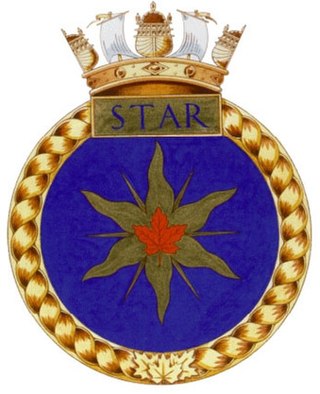The kingfisher is a bird in the family Alcedinidae.
Contents
Kingfisher can refer to:
The kingfisher is a bird in the family Alcedinidae.
Kingfisher can refer to:

The War of 1812, called the American War of 1812 in Britain, was fought by the United States and its indigenous allies against the United Kingdom and its own indigenous allies in British North America, with limited participation by Spain in Florida. It began when the United States declared war on Britain on 18 June 1812. Although peace terms were agreed upon in the December 1814 Treaty of Ghent, the war did not officially end until the peace treaty was ratified by the United States Congress on 17 February 1815.

Q-ships, also known as Q-boats, decoy vessels, special service ships, or mystery ships, were heavily armed merchant ships with concealed weaponry, designed to lure submarines into making surface attacks. This gave Q-ships the chance to open fire and sink them. The use of Q-ships contributed to the abandonment of cruiser rules restricting attacks on unarmed merchant ships and to the shift to unrestricted submarine warfare in the 20th century.

The Mare Island Naval Shipyard (MINSY) was the first United States Navy base established on the Pacific Ocean. It is located 25 miles (40 km) northeast of San Francisco in Vallejo, California. The Napa River goes through the Mare Island Strait and separates the peninsula shipyard from the main portion of the city of Vallejo. MINSY made a name for itself as the premier U.S. West Coast submarine port as well as serving as the controlling force in San Francisco Bay Area shipbuilding efforts during World War II.

USS Baltimore (CA-68) was the lead ship of her class of heavy cruiser, the fifth ship of the United States Navy named after the city of Baltimore, Maryland.

In the 18th century and most of the 19th, a sloop-of-war in the Royal Navy was a warship with a single gun deck that carried up to eighteen guns. The rating system covered all vessels with 20 guns and above; thus, the term sloop-of-war encompassed all the unrated combat vessels, including the very small gun-brigs and cutters. In technical terms, even the more specialised bomb vessels and fireships were classed as sloops-of-war, and in practice these were employed in the sloop role when not carrying out their specialised functions.
United States naval architects or ship designers introduced the faster and larger sailing frigates and sloop-of-wars of the early United States Navy which influenced the later merchant ships and clipper ships.
Fourteen ships of the Royal Navy have borne the name Kingfisher, after the kingfisher bird:

Thomas Charles Hart was an admiral in the United States Navy, whose service extended from the Spanish–American War through World War II. Following his retirement from the navy, he served briefly as a United States Senator from Connecticut.

The Mediterranean Squadron, also known as the Mediterranean Station, was part of the United States Navy in the 19th century that operated in the Mediterranean Sea. It was formed in response to the First and Second Barbary Wars. Between 1801 and 1818, the squadron was composed of a series of rotating squadrons. Later, squadrons were sent in the 1820s to the 1860s to suppress piracy, primarily in Greece and to engage in gunboat diplomacy. In 1865 the force was renamed the European Squadron.

USS Osborne (DD-295) was a Clemson-class destroyer in the United States Navy following World War I. She was named for Weedon Osborne.

HMS St Lawrence was a 102-gun first-rate wooden warship of the Royal Navy that served on Lake Ontario during the War of 1812. Built on the lake at the Royal Navy dockyard in Kingston, Ontario, she was the only Royal Navy ship of the line ever to be launched and operated entirely in fresh water. Constructed in 1814, the ship's arrival on the lake ended all naval action and St Lawrence finished the war having never gone into battle. Following the war, the vessel was laid up, eventually being sold in 1832 to private interests. The ship later sank and is now a recreational dive spot.

Amherstburg Royal Naval Dockyard was a Provincial Marine and then a Royal Navy yard from 1796 to 1813 in Amherstburg, Ontario, situated on the Detroit River. The yard comprised blockhouses, storehouses, magazine, wood yard and wharf. The yard was established in 1796 to support the Upper Canada Provincial Marine after Great Britain ceded a pre-existing shipyard on the Detroit River to the United States. Amherstburg Royal Naval Dockyard constructed four warships for the Lake Erie detachment of the Provincial Marine before and during the War of 1812. In 1813 the dockyard was abandoned and destroyed when the British retreated and never reopened. In 1928, the site was designated a National Historic Site of Canada.

HMS Kingfisher (L70) was a Royal Navy patrol vessel and the lead ship of the Kingfisher-class sloops, laid down in 1934 and commissioned in 1935. She took part in the Dunkirk evacuation, and spent much of the Second World War as an experimental trials ship. She was sold for scrap in 1947.
A ranger is typically either a caretaker that aids in the management of natural resources like public parks/forests or someone that works in a law enforcement or military/paramilitary role specializing in patrolling a given territory, called "ranging" or "scouting". The term most often refers to:

HMCS Star is a Canadian Forces Naval Reserve Division (NRD) located in Hamilton, Ontario. Dubbed a stone frigate, HMCS Star is a land-based naval establishment for training part-time sailors as well as functioning as a local recruitment centre for the Royal Canadian Navy (RCN). The second oldest of 24 naval reserve divisions located in major cities across Canada, Star was stood up on 15 March 1923 as the Royal Canadian Naval Volunteer Reserve (RCNVR) Hamilton Half Company and then on 1 November 1941 as HMCS Star.

HMS Kingfisher was the second ship in the 14-gun Swan class of ship sloops, to which design 25 vessels were built in the 1760s and 1770s. She was launched on 13 July 1770 at Chatham Dockyard, and completed there on 21 November 1770. She took part in the American Revolutionary War, enforcing the blockade of the Delaware Bay, and served in the Battle of Turtle Gut Inlet, near Cape May, New Jersey. While under the temporary command of Lieutenant Hugh Christian, she was burnt by her own crew to avoid capture on 7 August 1778 in Narragansett Bay during the Battle of Rhode Island.
HMS Kingfisher was an 18-gun sloop of the Royal Navy which saw service during the American War of Independence and the French Revolutionary Wars.
The following index is provided as an overview of and topical guide to Wikipedia's articles on recreational dive sites. The level of coverage may vary:

Recreational dive sites are specific places that recreational scuba divers go to enjoy the underwater environment or for training purposes. They include technical diving sites beyond the range generally accepted for recreational diving. In this context all diving done for recreational purposes is included. Professional diving tends to be done where the job is, and with the exception of diver training and leading groups of recreational divers, does not generally occur at specific sites chosen for their easy access, pleasant conditions or interesting features.